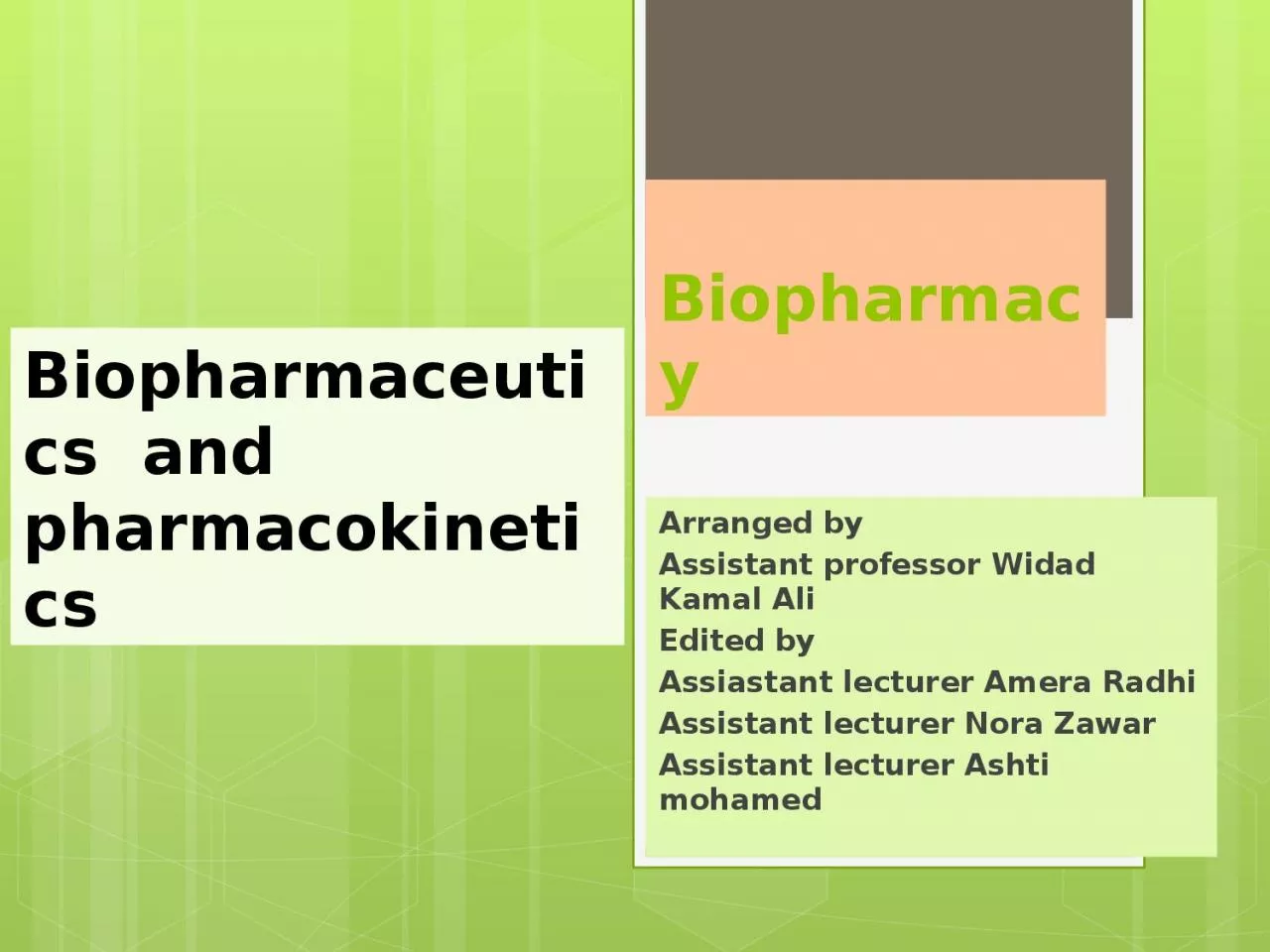

Assistant professor Widad Kamal Ali Edited by Assiastant lecturer Amera Radhi Assistant lecturer Nora Zawar Assistant lecturer Ashti mohamed Biopharmaceutics and pharmacokinetics ID: 918492
Download Presentation The PPT/PDF document "Biopharmacy Arranged by" is the property of its rightful owner. Permission is granted to download and print the materials on this web site for personal, non-commercial use only, and to display it on your personal computer provided you do not modify the materials and that you retain all copyright notices contained in the materials. By downloading content from our website, you accept the terms of this agreement.
Slide1
Biopharmacy
Arranged byAssistant professor Widad Kamal Ali Edited by Assiastant lecturer Amera RadhiAssistant lecturer Nora ZawarAssistant lecturer Ashti mohamed
Biopharmaceutics
and pharmacokinetics
Slide2Lab 2.In vitro evaluation of antacids
Slide3IntroductionThe Gastro-intestinal (GI) tract generates and maintains different pH environments along its length.
pH is very important for controlling activity of digestive enzymes.
Slide4ACIDITY IN THE STOMACH
Acidity in the stomach is normal, but excess acidity is potentially harmful. It is unusual compared to other organs as its pH is as low as 1-2 due to production of hydrochloric acid from structures in lining of walls. Acid environment kills bacteria that comes in with food, is optimum for activity of digestive enzymes
Slide5EXCESS ACID
Factors that cause excess production of gastric juice (acidic secretion) Excess alcohol Smoking Stress Some anti-inflammatory drugs
Slide6Acid indigestion or dyspepsia is an illness commonly treated by self-medication.
Antacids are drugs which on ingestion react with the hydrochloric acid of gastric content to lower the acidity.Antacids are alkalis, such as aluminium hydroxide, magnesium salts (magnesium hydroxide and magnesium trisilicate),sodium bicarbonate, and calcium hydroxide.The finished product must raise the pH of gastric secretions to 3.5 or greater within 10 minutes.
Slide7They are simple ,often effective treatment for many dyspepsia's (impairment of the power or function of digestion),and provide symptomatic relief in conditions such as peptic ulcer, gastritis (inflammation of the lining of the stomach) ,and esophageal reflux with heartburn.
Slide8Slide9Slide10They are generally formulated in combinations ,for example:
magnesium hydroxide +aluminium hydroxide Or with other components, such as: Simeticone (activated dimeticone, an anti-foaming agent), Alginates (anti-reflux agents).
Slide11Antacids may be divided into two main groups according to their water solubility:
Slide12Antacids ,by altering gastric pH, may interfere with drug absorption in number of ways:
Altered drug ionization :e.g. carbenoxolone (an ulcer healing drug),its absorption is completely inhibited above pH 2 and therefore ,it should not be given with antacids.Alteration of gastric emptying : The stomach empties more readily when pH increaeses.
Slide13Drug dissolution may be affected by pH changes.
Drug interaction: calcium , aluminium and magnesium decrease the gastric absorption of tetracyclines due to complex formation with it.Systemic effect : Systemic antacids may accelerate the excretion of drugs(salicylates) and inhibit the urinary excretion of basic drugs ,e.g. amphetamines.It seems advisable to administer other drugs at least one half to one hour before antacids ingestion in order to assure consistent absorption and effect.
Slide14Several factors must be considered when selecting an antacid product
Slide15Slide16Slide17Slide18Mg (OH)2 and CaCo3 have rapid onset of action.MgCO3 : Intermediate onsetMg
trisilicate and aluminium compounds have slow onset.
Slide19Aim of the experiment:
The objective of this experiment is to evaluate in vitro , a number of antacid marketed products and compare their buffering capacity .
Slide20Principle
A simple procedure is used, to imitate the physiological conditions in the stomach . Techniques of alternate addition and removal of (0.1N HCI )solution are used to mimic the release of HCL from the oxyntic cells and the periodic emptying of the stomach.
Slide21Experimental
A quantity of 2gm of finely ground powder or its equivalent of formulations was added to 100ml of 0.1N HCI. The pH of the mixture was determined after the intervals of 0.5, 2, 4, 6, 8 and 10 minutes. A quantity of 20ml of the mixture was then removed by a pipette and replaced by 20ml fresh 0.1N HCI.
Slide22The process was repeated at 10 minutes interval until a pH below 2.75 was reached which shows that the buffering power of antacid was
spent out.the time at which pH falls below 2.75 was used as measure of buffering capacity
Slide23Enter your results in a table and plot a graph against time as you conduct the experiment.
Slide24PH of the mixture
Time in minutes0.5246
8
10
20
40
50